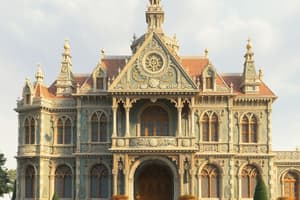Podcast
Questions and Answers
What is the relationship between the center of gravity and stability?
What is the relationship between the center of gravity and stability?
- A lower center of gravity generally leads to less stability.
- A higher center of gravity generally leads to less stability. (correct)
- The center of gravity and stability are not related.
- There is no relationship between the center of gravity and stability.
In the context provided, what does the term "Aesthetics" likely refer to?
In the context provided, what does the term "Aesthetics" likely refer to?
- The emotional impact of an object.
- The study of beauty and art.
- The functional design of an object.
- The physical appearance of an object. (correct)
What is the likely implication of the statement "Centre of gravity is approximately along the line of symmetry"?
What is the likely implication of the statement "Centre of gravity is approximately along the line of symmetry"?
- The object is aesthetically pleasing.
- The object is symmetrical.
- The object is balanced. (correct)
- The object is strong and durable.
Which of the following factors can influence the stability of an object?
Which of the following factors can influence the stability of an object?
What is the most likely reason for the text to mention both Aesthetics and Stability?
What is the most likely reason for the text to mention both Aesthetics and Stability?
Flashcards
Aesthetics
Aesthetics
The branch of philosophy dealing with beauty and artistic taste.
Centre of Gravity
Centre of Gravity
The point where the weight of an object is evenly distributed in all directions.
Line of Symmetry
Line of Symmetry
A line that divides a shape into two identical parts that are mirror images.
Stability
Stability
Signup and view all the flashcards
Balance
Balance
Signup and view all the flashcards
Study Notes
Form, Function, and Design of Structures
- Structures have a defined size, shape, and purpose, and can hold a load.
- Engineers must first determine the function of a structure
- Aesthetics (looks), cost of development, safety, and health impacts are important considerations alongside legal restrictions and lifespan.
What Is a Structure?
- A structure is something with a definite size, shape, and purpose that can hold a load.
- Engineers consider the intended purpose of the structure when designing it
What Is Form?
- Form encompasses the shape, size, and materials of a structure.
- Structures are designed to best utilize materials in the structure's form.
What Is Function?
- Function refers to the structure's purpose or ability to perform a specific task.
- Form follows function is a design principle emphasizing that the structure's form should reflect its purpose.
Types of Structures
- Structures are categorized as shell, frame, or solid.
- Shell structures use an outer layer for support, like glass jars, cans, and eggshells.
- Frame structures rely on interconnected components to form a framework; these can be two or three-dimensional. Examples are fences and houses.
- Solid structures are made of one piece of solid material and can also be called mass structures; examples include dams and pyramids.
Forces on Bridges
- Bridges are useful for crossing waterways and gaps, opening access to previously inaccessible areas.
- Bridges need to have strength against internal and external forces to ensure safety.
- Internal forces include compression, tension, shear, and torsion.
- External forces include gravity, wind, and water.
Ergonomics
- Ergonomics is the study of how tools, furniture, and workplaces can be designed to allow people to work comfortably and efficiently.
- Proper positioning can prevent musculoskeletal disorders.
- The 90-90-90 rule for sitting at a desk recommends maintaining a 90-degree angle at the feet, knees, and back. Desks should be adjusted so that screens are at eye level. Frequent breaks are also essential.
Symmetry
- Symmetry is when an object appears the same on both sides.
- In structures, symmetry involves a general balance and harmony.
- Symmetry aids in stability. The centre of gravity is often situated along the line of symmetry in a structure because this enhances stability.
- Aesthetically pleasing structures often display symmetry.
Studying That Suits You
Use AI to generate personalized quizzes and flashcards to suit your learning preferences.




